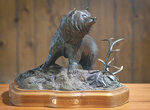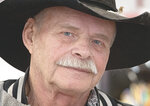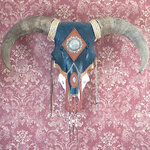Mostly Cloudy, 64° F
It’s not unusual to find Powell artist Jerry Johnson seeking solace along the banks of the Shoshone River, but you’ll never find him there without his pup, Bear. He does his best thinking …
This item is available in full to subscribers.
The Powell Tribune has expanded its online content. To continue reading, you will need to either log in to your subscriber account, or purchase a subscription.
If you are a current print subscriber, you can set up a free web account by clicking here.
If you already have a web account, but need to reset it, you can do so by clicking here.
If you would like to purchase a subscription click here.
Please log in to continue |
|





It’s not unusual to find Powell artist Jerry Johnson seeking solace along the banks of the Shoshone River, but you’ll never find him there without his pup, Bear. He does his best thinking outdoors. It helps him parse the upsetting news of the world.
He went for an extra long walk after the last presidential election, his wife Patty reported, knowing well his need for the comfort of nature when troubled.
But other than on the river near his country home, Johnson is pretty hard to find. The artist doesn’t have a website and he never advertises. There was a time when his work could be found in art galleries and, a handsome cowboy in his prime, he was even a model briefly. But now he prefers to spend much of his time in the mountains looking for interesting pieces of wood and antlers for art projects, watching wildlife and making memories while spending his time with his family and fur babies.
One caution; if you’re lucky enough to get an invite to his shop, avoid the cat, which is fittingly named Scratchy.
Johnson never thought about being an artist until fairly late in his life. He was born on a ranch in North Dakota and faced challenges that have molded him, his vision and his desire to seek time in the wilderness. At a very young age, Johnson’s mother was killed in an unimaginably horrific farm accident while the young couple struggled to scratch out a living in the northern plains.
“My younger brother and I had to go live with our grandparents until I was in first grade because my dad was busy. He had just bought the farm and was trying to get it going,” he said.
He never thought about art in school. His creativity was more on the practical side at a time when hard labor was the norm. After high school Johnson went to a trade school for pipe fitting and chose Wyoming in their placement program. His chosen profession didn’t last long. After he “broke” a few horses in his spare time for a rancher in Worland, the mountains called.
He quickly found a job at the Bill Cody Ranch, leading wilderness pack trips in the summer and guiding hunts in the fall. But there wasn’t much money in it so he took a winter job doing manual labor for Roger Rousu, artist and longtime owner of a bronze foundry in nearby Cody.
Rousu took him under his wing, teaching him everything he would ever need to know about casting bronze sculptures. But Rousu’s advice was more than just learning technique. For the first time in his life, Johnson had met someone to help him uncover his suppressed artistic creativity.
Johnson has never had an art class. He was raised to be practical and art didn’t fit that mold. However, after meeting Rousu and learning how to make his own molds, the flood gates opened. Years after making his first sculpture — a longhorn steer resting in a pasture for which he won an award — Johnson decided to paint.
“I learned oil painting by watching Bob Ross on TV,” he said.
His subjects are scenes from his life in the West; sculptures of Yellowstone Ecosystem wildlife, livestock, dogs and American Indian themes. Then he started making furniture, “perfect for log cabins,” he said.
The furniture is made from a combination of old, rotting logs and colorful epoxy and semi-precious gems like turquoise and supported by found antlers of local ungulates.
Johnson spends days and weeks searching for perfect dead and dried logs and branches, mostly pine and cedar, for each one-of-a-kind piece. He would often take his horses and mules into the mountains searching for inspiration.
“I’d ride up on the horse into the canyon. Every day I’d take my boots off and put baseball spikes on, or golfing shoes, because it was really slick on the north side of the hill at that time. You know, it was March,” he said while looking at a photograph of his horse loaded with horns. “I called him Holiday because he was a Christmas present.”
He would stay in the hills for weeks. When he found horns he would stash them out of sight. Then, after a month or more, he’d round up the livestock, break camp and ride back to town.
“I've used up most of them that I hunted,” he said. “They [the furniture] take two big six point horns, so you use them up fast.”
Since arriving in Powell in 1999 to work a heavy-equipment operating job in Elk Basin, Johnson has been making art out of skulls he has found. He combines painting and hydro-dipping, a method of applying printed graphics to three dimensional objects, in transforming old skulls into fetching display pieces. But despite his art being purchased by clients “around the world,” you won’t find his work online or in galleries at this point in his career.
“Now it's just word of mouth,” he said. “I'm retired. I don't want to be forced to do it.”
Jan Sapp, owner of Heartworks in Powell, understands Johnson stepping away from “production” after retirement. Johnson was one of the first artists to populate the crafters’ community when it opened.
“When an artist has to make something it can take the joy out of creating it,” she said in a Wednesday interview.
The artists associated with Heartworks aren’t pressured to produce, “unless it’s Christmas,” Sapp quipped. She’s a big fan of Johnson’s art and remembers one bronze of a dog they had for sale in the store that people adored. Some would pet the bronze, she recounted. Another man, who had lost his retriever, came to tears when he first saw the life-like sculpture.
“He was an asset here because his art is so varied and unique. And just, it was striking,” Sapp said.
Despite his struggles through the years, working jobs for little pay and seemingly always on the move, Johnson has found riches allowing him to concentrate on his art. Oil was found under the dirt of his family’s modest farm, which is located in the most productive region of the Bakken Formation in western North Dakota.
“We don’t make a lot from each well, but we have a lot of them out there,” he said.
He knows he’s been lucky at times. Through tragedy and a lot of manual labor he managed to raise three children in a previous relationship and kept the lights on. And while his artwork has previously sold for thousands each in galleries, now he only sells a few pieces here and there to pay the rising costs of finding resources and pouring bronze.
“I keep my stuff way low so people can afford it. But you’ve got to make your foundry costs back,” he said.
He finds much joy in knowing his artwork is out there — having sold to clients around the world. But now it’s all about doing a small number of quality pieces on commission at his own pace and spending time with family, pets and getting to the mountains as often as possible.
He requires a lot of time on the trails with Bear. He, like most retirees, is anxious about the economy. Television news only exasperates the situation, though the frequent hikes help.
“If you think you're gonna live on Social Security, you're kidding yourself. You can't even pay your supplemental insurance with it,” he complained after being cooped up in the house for days due to the brutal sub-zero weather.
“Bear can take that walk when it's below zero. I can’t,” he said. He has spent most of his time recently in a steel-sided building where he makes his art. A large pine sign inscribed with Walkingstar, his brand, hangs above the door to the heated shop.
There, many projects are waiting for finishing touches. But if you know Johnson well enough, you understand that a nice hike down by the river with Bear might be the thing he needs to find the inspiration to finish.